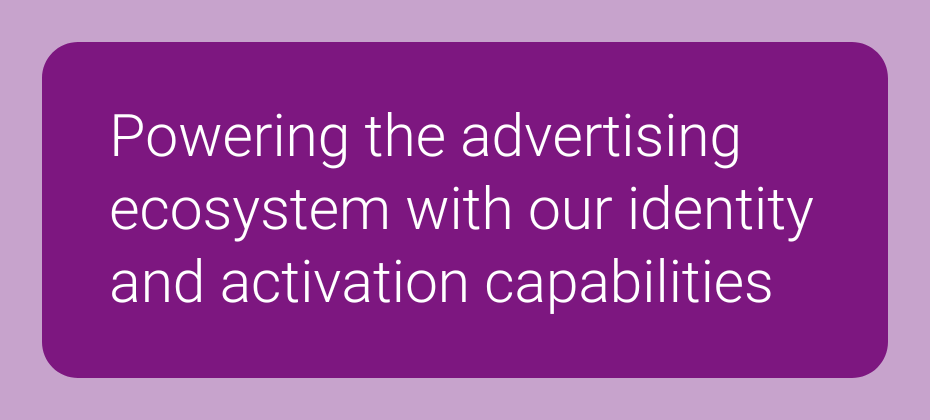
The cookieless future is here, and it’s time to start thinking about how you will adapt your strategies to this new reality. In a cookieless world, you will need to find new ways to identify and track users across devices. This will require reliance on first-party data, contextual advertising, and alternative identifiers that respect user privacy.
To shed light on this topic, we hosted a panel discussion at Cannes, featuring industry leaders from Cint, Direct Digital Holdings, the IAB, MiQ, Tatari, and Experian.

In this blog post, we’ll explore the future of identity in cookieless advertising. We’ll discuss the challenges and opportunities that this new era presents, and we’ll offer our tips for how to stay ahead of the curve.
How cookieless advertising is evolving
Programmatic advertising is experiencing multiple changes. Let’s dive into three key things you should know.
Cookie deprecation
One significant change is cookie deprecation, which has implications for tracking and targeting. Additionally, understanding the concept of Return on Advertising Spend (ROAS) is becoming increasingly crucial.
The demand and supply-side are coming closer together
Demand-side platforms (DSPs) and supply-side platforms (SSPs) have traditionally been seen as two separate entities. DSPs are used by advertisers to buy ad space, while SSPs are used by publishers to sell ad space. However, in recent years, there has been a trend toward the two sides coming closer together.
This is due to three key factors:
The rise of header bidding
Header bidding is a process where publishers sell their ad space to multiple buyers in a single auction. This allows publishers to get the best possible price for their ad space, and it also allows advertisers to target their ads more effectively.
Cookie deprecation
As third-party cookies are phased out, advertisers need to find new ways to track users, and they are turning to SSPs for help. SSPs can provide advertisers with data about users, such as their demographics and interests. This data can be used to target ads more effectively.
The increasing importance of data
Advertisers are increasingly looking for ways to target their ads more effectively, and they need data to do this. SSPs have access to a wealth of user data, and they’re willing to share this data with advertisers. This is helping to bridge the gap between the two sides.
The trend toward the demand-side and supply-side coming closer together is good news for advertisers and publishers. It means that they can work together to deliver more relevant ads to their users.
Measuring and tracking diverse types of media
The media measurement landscape is rapidly evolving to accommodate new types of media, such as digital out-of-home (DOOH). With ad inventory expanding comes the challenge of establishing identities and connecting them with what advertisers and agencies want to track.
Measurement providers are now being asked to accurately capture instances when individuals are exposed to advertisements at a bus stop in New York City, for example, and tracking their journey and purchase decisions, such as buying a Pepsi.
To navigate cookieless advertising and measurement, we must prioritize building a strong foundational identity framework.
What you should focus on in a cookieless advertising era
In a cookieless advertising era, you will need to focus on two key things: frequency capping and authentic identity.
Frequency capping
Frequency capping is a practice of limiting the number of times an ad is shown to a user. This is important in cookieless advertising because it helps to prevent users from being bombarded with ads. It also helps to ensure that ads are more effective, as users are less likely to ignore or click on ads that they have seen too many times.
Frequency capping is often overhyped and yet overlooked. Instead of solely focusing on frequency, consider approaching it from an identity perspective. One solution could be to achieve a perfect balance between reaching a wider audience and avoiding excessive repetition. By increasing reach in every programmatic buy, you naturally mitigate frequency control concerns.
Authentic identity
The need for authentic identities in a digital and programmatic ecosystem is undeniable. While we explore ways to connect cookies, mobile ads, and other elements, it’s crucial to remember who we are as real individuals. By using anonymized personal identifying information (PII) as a foundation, we can derive insights about households and individuals and set effective frequency caps across different channels.
Don’t solely focus on devices and behaviors in your cookieless advertising strategy and remember the true value of people and their identities.
What’s next for cookieless advertising?
The deprecation of third-party cookies is a major challenge for the digital advertising industry. Advertisers will need to find new ways to track users and target their ads.
Here are three specific trends that we can expect to see in cookieless advertising.
First-party data is moving in-house
Many major media companies, equipped with valuable identifier and first-party data, are choosing to bring it in-house. They are focused on using their data internally rather than sharing it externally.
“Many larger media companies are opting to bring their identifier and first-party data in-house, creating more walled gardens. It seems that companies are prioritizing data control within their own walls instead of sharing it externally.”
laura manning, svp, measurement, cint
Fragmentation will continue
The number of identifiers used to track people online is growing rapidly. In an average household, over a 60-day period, there are 22 different identifiers present. This number is only going to increase as we move away from cookies and toward other identifiers.
This fragmentation makes it difficult to track people accurately and deliver targeted advertising. This means that we need new identity solutions that can help make sense of these new identifiers and provide a more accurate view of people.
A portfolio of solutions will address signal loss
Advertisers are taking a variety of approaches to cookieless advertising. A few of the solutions include:
- Working with alternative IDs.This refers to using alternative identifiers to cookies, such as mobile device IDs or email addresses. These identifiers can be used to track people across different websites and devices, even without cookies.
- Working with data index at a geo level. This refers to using data from a third-party provider to get a better understanding of people’s location. This information can be used to target ads more effectively.
- Working with publisher first-party data that’s been aggregated to a cohort level. This refers to using data that is collected directly from publishers, such as website traffic data or purchase history. This data can be used to create more personalized ads.
- Working with contextual solutions. This refers to using contextual data, such as the content of a website or the weather, to target ads. This can help to ensure that ads are relevant to the user’s interests.
“Cookie deprecation is often exaggerated, and alternate solutions are already emerging. As data moves closer to publishers and first-party data gains prominence, the industry will adapt to the changes.”
mark walker, ceo, direct digital holdings
There is no one-size-fits-all solution for cookies, and you will need to be flexible and adopt a variety of different approaches.
How will these solutions work together?
You can take a waterfall approach to cookieless advertising. A waterfall approach is a process where advertisers bid on ad impressions in sequential order. The first advertiser to meet the minimum bid price wins the impression.
In the context of cookieless advertising, a waterfall approach can be used to prioritize different targeting signals. For example, you might start by bidding on impressions that have a Ramp ID, then move on to impressions that have a geo-contextual signal, and finally bid on impressions that have no signal at all.
This is a flexible approach that can be adapted to different needs and budgets.
Watch our Cannes panel for more on cookieless advertising

We hosted a panel in Cannes that covered the future of identity in cookieless advertising. Check out the full recording below to hear what leaders from Cint, Direct Digital Holdings, the IAB, MiQ, Tatari, and Experian had to say.
Check out more Cannes content:
- Our key takeaways from Cannes Lions 2023
- Insights from a first-time attendee
- Four new marketing strategies for 2023
- Exploring the opportunities in streaming TV advertising
- Maximize ad targeting with supply-side advertising
Follow us on LinkedIn or sign up for our email newsletter for more informative content on the latest industry insights and data-driven marketing.
Get in touch
Latest posts

At Experian, we understand the importance of audience targeting when it comes to crafting a successful marketing campaign. We are excited to share a curated list of audience recommendations to support your campaign planning so you can confidently connect with your audience. What separates Experian’s syndicated audiences Experian’s 2,400+ syndicated audiences are available directly on over 30 leading television, social, programmatic advertising platforms, and directly within Audigent for activation within private marketplaces (PMPs). Reach consumers based on who they are, where they live, and their household makeup. Experian ranked #1 in accuracy by Truthset for key demographic attributes. Access to unique audiences through Experian’s Partner Audiences available on Experian’s data marketplace, within Audigent for activation in PMPs and directly on platforms like DirectTV, Dish, Magnite, OpenAP, and The Trade Desk. New and improved audience segments we recommend for Q1 campaigns Q1 is the ultimate season for TV, with the NFL playoffs, Super Bowl, College Football playoffs, award shows and so much more capturing viewers’ attention. That’s why we're excited to introduce 14 new and 8 updated television audiences. Recently released on major platforms, these new television audiences offer unique opportunities to align your campaign planning with the latest viewer behavior trends. Cable Satellite or Streaming Network Subscribers Satellite Service Subscribers Mutli Brand TV Owners Seasonal audiences for Q1 New Year’s audiences As the new year approaches, it’s the ideal moment to connect with consumers inspired by their New Year’s resolutions. In 2024, one-third of U.S. adults set goals for the year, focusing on key areas like healthier living, getting organized, exploring new experiences, and improving financial wellness. Experian’s New Year’s resolution audiences provide valuable insights into these aspirations, allowing you to tailor your messaging and engage with consumers determined to make positive changes in 2025. From promoting healthy lifestyles and travel to supporting organization and financial goals, Experian’s data-driven solutions help you capture these motivated audiences with precisely targeted messaging. Learn more here Football audiences Football season presents an unmatched opportunity for brands to connect with one of the most engaged audiences in the U.S. As in-game ad costs continue to rise and slots fill up quickly, brands are seeking innovative ways to reach passionate football viewers beyond the game. Experian’s specialized football audience segments allow advertisers to engage with fans across categories like NFL stadium visitors, college football enthusiasts, beer drinkers, and dedicated TV viewers, ensuring your brand connects meaningfully with consumers throughout the season. Read more here Financial audiences With tax season just around the corner, brands have the opportunity to connect with financially engaged audiences in the U.S. Whether your goal is to reach self-starters managing their own returns or high-net-worth individuals seeking advanced tax solutions, Experian can ensure your brand connects meaningfully with the right financial audience at the right time. Experian’s specialized financial audience segments empower brands to engage with key groups, such as: Tax Return – Self prepare user Tax Return – Online tax software user Tax Return – Professional Service Preparer user Savvy Sounding-Board Seeking Investor Price Sensitive, Self-Directed Investor Top recommendations for Q1 Based on the top Experian audiences activated in Q1 of 2024, our top 10 list is designed to assist agencies and media buyers plan data-driven advertising campaigns. Occupation 1) Small Business Owners: This segment contains consumers who are likely to be small business owners. 2) Military – Inactive: This segment contains consumers who are likely to be inactive in the military. 3) Legal/Education and Health Practitioners: This segment contains consumers who are likely to have an occupation in Legal/Education and Health Practitioner. 4) Technical: Computers/Math and Architect/Engineering: This segment contains consumers who are likely to have an occupation in Computers/Math and Architect/Engineering. Consumer Lifestyles 5) Vacation/Leisure Travelers: Weekend Getaways: This segment contains consumers who are likely high spenders or frequent purchasers of weekend getaway travel. 6) Women's Sleepwear and Lingerie: High Spenders: This segment contains consumers who are likely high spenders at women's sleepwear and lingerie stores (e.g., Soma, Victoria's Secret). 7) Smart Investors: This segment contains consumers who are likely actively seeking out as much information about an investment as possible before committing, shopping around for the best investment deal, and aversion to financial debt. 8) Computers/Software Frequent Spenders: This segment contains consumers who are likely frequent spenders of computer software. Life Events 9) New Movers: High Spenders: This segment contains consumers who are likely new mover high spenders. 10) New Parents: Child Aged 0-36 Months: This segment contains consumers who are likely to be new parents for children aged 0-36 months. You can find the complete audience segment name in the appendix. Activate the right audiences with Experian For a full list of Experian’s syndicated audiences and activation destinations, download our syndicated audiences guide. Need a custom audience? Reach out to our audience team and we can help you build and activate an Experian audience on the platform of your choice. Connect with our audience team Contact us Appendix Here are the complete audience segment names (taxonomy paths) for all audience segments discussed in this blog post. TV Audiences Television (TV) > Household/Family Viewing > Cable Satellite or Streaming Network Subscribers Retail Shoppers: Purchase Based > Seasonal > Discount Holiday Shoppers Television (TV) > Brand Owners > Multi Brand TV Owners Financial Audiences Lifestyle and Interests (Affinity) > Financial Behavior > Tax Return – Self prepare user Lifestyle and Interests (Affinity) > Financial Behavior > Online Tax Software user Lifestyle and Interests (Affinity) > Financial Behavior > Tax Return –Professional Service Prepare user Financial Personalities > Investments Financial Personality > Savvy Sounding-Board Seeking Investor, Average Investable Assets Financial Personalities > Investments Financial Personality > Price Sensitive, Self-Directed Investor, Very High Investable Assets Occupation Consumer Behaviors > Occupation: Small Business Owners Lifestyle and Interests (Affinity) > Occupation > Military – Inactive Demographics > Occupation > Professional: Legal/Education and Health Practitioners Demographics > Occupation > Technical: Computers/Math and Architect/Engineering Consumer Lifestyles Retail Shoppers: Purchase Based > Travel > Vacation/Leisure Travelers: Weekend Getaways Retail Shoppers: Purchase Based > Apparel > Women's Apparel (Clothing): Women's Sleepwear and Lingerie: High Spenders Financial Behavior > Smart Investors Retail Shoppers: Purchase Based > Technology/Telecom > Computers/Software Frequent Spenders Life Events Retail Shoppers: Purchase Based > Shopping Behavior > New Movers: High Spenders Life Events > New Parents > Child Age 0-36 Months Latest posts

The advertising ecosystem has seen significant transformation over the past few years, with increased privacy regulation, changes in available signals, and the rise of channels like connected TV and retail media. These changes are impacting the way that consumers interact with brands and how brands understand and continue to deliver relevant messages to consumers with precision. Experian has been helping marketers navigate these changes, and as a result, our marketing data and identity solutions underpin much of today’s advertising industry. We’re committed to empowering marketers and agencies to understand and reach their target audiences, across all channels. Today, we are excited to announce our acquisition of Audigent—a leading data and activation platform in the advertising industry. With Audigent’s combination of first-party publisher data, inventory and deep supply-side distribution relationships, publishers, big and small, can empower marketers to better understand their customers, expand the reach of their target audiences and activate those audiences across the most impactful inventory. I am excited to bring together Audigent’s supply-side network as a natural extension to our existing demand-side capabilities. Audigent’s ability to combine inventory with targeted audiences using first-party, third-party and contextual signals provides the best of all worlds, allowing marketers to deliver campaigns centered on consumer choices, preferences, and behaviors. The addition of Audigent further strengthens our strategy to be the premier independent provider of marketing data and identity, ultimately creating more relevant experiences for consumers. To learn more about Experian and Audigent, visit https://www.experian.com/marketing/ and https://audigent.com/. Contact us

Retail media has been on everyone’s radar for a while. Commerce media has also established itself as a significant player in the AdTech industry over the past few years. While retail media focuses on engaging customers within a retailer’s ecosystem, commerce media goes beyond these boundaries to capture the entire shopping journey, spanning multiple touchpoints, channels, and platforms.But what is commerce media, and why should we care? Commerce media is here to stay Estimated to hit $33.86 billion this year and more than double by 2028, the hunt is on to capture as much of retail media’s projected ad spend as possible. However, given the numerous verticals expanding their retail media strategy to include any touchpoint within the commerce channel, it might be time to lower the retail media flag and hoist the LUMA dubbed "commerce media flag." So why are Travel, Financial Services, and other verticals focusing on the commerce media ship? Authenticated and digital users (usually app-driven) Consented data that provides unique insight into the household’s or consumer’s intent/purchase behavior Emerging focus on advertising as an important revenue stream for the future With all this “data” at their disposal — why is it not smooth sailing for commerce media to build an ad-supported business? What’s missing for them to acquire the lucrative billions efficiently and effectively? Why retail media networks are important Retail media networks (RMNs) are now a major tool for brands to connect with shoppers. These networks gather valuable data from customers who browse and shop on e-commerce sites and apps. What makes RMNs so powerful is that they allow brands to advertise directly to people who are already interested in buying, leading to more successful sales. For marketers, RMNs offer a clear way to reach potential customers and ensure their advertising dollars are well spent. But as competition grows and consumer habits change, these networks must keep improving. To stay ahead, brands will have to find new ways to use RMNs effectively, linking them with other parts of the commerce media world to unlock even greater results. Differences between building a loyalty program and developing ad products Loyalty programs are the backbone of commerce media networks; however, creating a loyalty program is much different than building an advertising product. It requires commerce companies to bring on additional people, technology, and partners to execute flawlessly. There are four areas to consider: 1. Organizing your data at scale To successfully build an ad-supported business at scale, data must be organized to initiate action (targeting and/or measurement). However, this requires changes in company culture. Both the business and technology infrastructure must be updated. Additionally, commerce media companies must update their mindset around creating and selling products. 2. People We have seen this story before, with large opportunities comes the requirement for new talent. Where are we seeing commerce media companies recruit from? AdTech and MarTech. Whether it’s engineers or data scientists, business development and partnership leads, or even your direct sales team, the poaching has begun. To build a successful business around advertising, experts are needed who can navigate the waters. 3. Partner vs. build The Requests for Information (RFIs) and Requests for Proposals (RFPs) for any combination of agency, demand-side platform, supply-side platform, customer data platform, identity graph, clean room, and beyond are piling up. One trend is clear: commerce media companies are looking for collaborative partners to provide a true strategic partnership to take on the complexities of the transition away from retail media. 4. Identity will remain the keystone to success All commerce media companies have some identity data that reveals a slice of their customers’ viewpoint. Yet, unlocking the broad view of these audiences is crucial to success. These companies need to use the “full pie” to see well-rounded profiles, gain the reach required to access them across many channels, and turn opportunities into revenue. Advertisers can finally close the loop with commerce media networks Commerce media companies with real-time transaction data enable advertisers to see true ROI on their ad spend when products move off the shelves. Measuring real product lift/sale touch points across multiple channels will put performance and measurement front and center. Programmatic was the promise of performance advertising. Well, commerce media may finally fulfill that vow, creating enough value for companies to make it a real competitor to social channels. While retail media will always exist, the transition to commerce media has become increasingly popular and is here to stay. The journey might not be a straight shot to perfect results, but the data, partnerships, and resources are out there and ready to hop aboard to help guide commerce media companies to success. The future of commerce media Commerce media shows no signs of slowing down. More industries are seeing the benefit of making every customer touchpoint an opportunity to drive sales. Whether through social media shopping or in-app purchases, commerce media pushes businesses to create smoother, more connected shopping experiences for consumers. In the future, brands won’t just compete on prices or products — they’ll stand out by offering simple, seamless shopping experiences across all devices. With better data and tools to track consumer behavior, brands will be able to personalize their ads and measure their success in real time. Commerce media allows brands to see a direct link between their ads and sales. Those who can adapt and keep up with these changes will come out on top. Create a connected customer view with Experian At Experian, we empower RMNs to unlock the full potential of their first-party data through comprehensive identity and audience solutions. Our data-driven capabilities enable RMNs to build a deeper understanding of their customers, optimize audience targeting across channels, and create enriched, actionable segments that drive measurable outcomes. By seamlessly connecting our offline and digital data, we help RMNs organize identities into households, device IDs, and more. Each household is enriched with valuable marketing insights, allowing you to gain better customer understanding, create targeted advertising, and reach the right customers across different devices. Additionally, you’ll be able to measure the effectiveness of your advertising efforts. With our support, RMNs can maximize revenue opportunities, extend reach, and confidently demonstrate the value of the network to advertisers. Contact us today to find out how Experian can help you succeed in commerce media. Contact us Latest posts